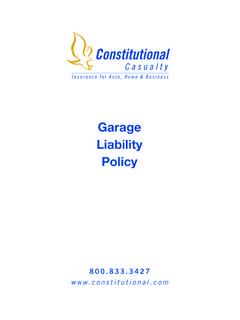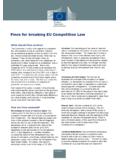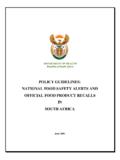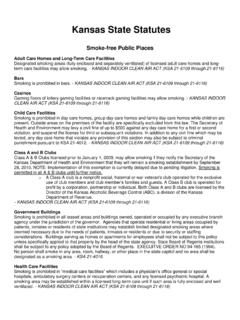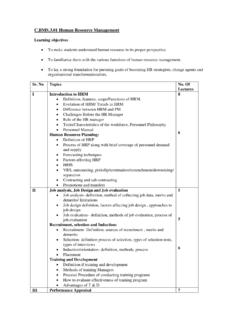Transcription of VI. E-COMMERCE: IMPACTS AND POLICY CHALLENGES
1 VI. E- commerce : IMPACTS AND POLICY . CHALLENGES1. Introduction1. In 1991, the Internet had less than 3 million users around the world and its Electronic commerce is a application to e- commerce was non-existent. By 1999, an estimated 250 million relatively recent application users accessed the Internet and approximately one quarter of them made purchases of the Internet . online from electronic commerce sites, worth approximately $110 billion. If the expansion in e- commerce continues at this rapid pace, as is expected, then in four to five years from now, e- commerce transactions between businesses (B2B) and between businesses and consumers (B2C) will account for about 5 per cent of inter-company transactions and retail sales respectively.
2 Looking forward, the poten- tial for e- commerce transactions to gain a sizeable share of consumer and business purchases appears to be large, although it is difficult to quantify. The prospect that e- commerce transactions may gain a sizeable share of overall creating new marketplaces commerce is only one dimension of why the Internet is generating such interest. The and opportunities for the open structure of the Internet and low cost of using it permit the interconnection of reorganisation of business new and existing information and communication technologies, and offers busi- processes . nesses and consumers an innovative and powerful information system and another form of communication. This makes it possible for buyers and sellers to come together in more efficient ways and is creating new marketplaces and opportunities for the reorganisation of economic processes.
3 It is also changing the way products are customised, distributed and exchanged and how businesses and consumers search and consume products. In the decades to come, exploiting the full potential of these developments with potential IMPACTS on could have profound IMPACTS in individual sectors of the economy as well as for growth and welfare and macroeconomic performance and economic policies. At the aggregate level, produc- implications for economic tivity and economic growth could rise, at least for some time, as a result of more effi- policies cient management of supply and distribution, lower transaction costs, low barriers to entry and improved access to Moreover, even if the impact of e-com- merce on GDP is small and uncertain it could enhance welfare because, for example, of saved time, greater convenience and access to a wider selection of goods and ser- vices more finely tuned to individual needs.
4 Nonetheless, to fully exploit the oppor- tunities much remains to be done to ameliorate user and consumer trust, improve access to the Internet infrastructure and services, and to create a stable, predictable 1. This chapter has benefited extensively from the guidance and comments received from the Director- ates for Science, Technology and Industry and Financial, Fiscal and Enterprise Affairs. 2. See the previous chapter of this Outlook for an analysis of economic growth performance in OECD. countries. OECD 2000. 194 - OECD Economic Outlook 67. regulatory Assessing the potential outcomes and economic IMPACTS of e- commerce , the forces underlying its expansion, and the possible implications for structural and macroeconomic POLICY management is the focus of this Given, however, the recent advent of the Internet and the fact that only scattered empirical information is available it needs to be stressed that the POLICY consequences of e- commerce can at this stage only be speculated about and are in many respects distant.
5 Defining and measuring e- commerce The term e- commerce has no The term e- commerce has no widely accepted definition. In a loose sense it means widely accepted definition doing business over the Internet, selling goods and services which are delivered offline as well as products which can be digitised and delivered online, such as computer Trades can be among businesses or between businesses and consumers. But the Internet also encompasses a wider spectrum of potential commercial activities and information exchanges. For instance, it offers firms, individuals and governments an electronic infrastructure which enables the creation of virtual auction markets for goods and services where previously they did not exist.
6 , for example, was among the first successful sites to provide a framework where consumers can trade a wide diversity of goods and services with each other (consumer to consumer, C2C). and, at least in principle, with businesses (consumer to business, C2B). Likewise, in some countries, including Australia, the United Kingdom and the United States, gov- ernments are beginning to reorganise the management of public procurement systems equivalent to some 10 per cent of GDP over the Internet, opening the pros- pect of sizeable B2G transactions. The technology is also being used by governments for the transmission or receipt of information (G2B, G2C) to improve the convenience and lower the cost of payment systems and tax compliance (C2G), and by businesses to manage after sales service and to develop direct consumer marketing.
7 This chapter, however, focuses mostly on two parts of the e-economy: B2B and B2C, where most development and progress to date has taken place and which is in this chapter, collectively referred to as e- commerce (Figure ). and few internationally It is difficult to measure how widespread e- commerce is. Two often-cited indicators comparable statistics are that can be compared internationally are the numbers of Internet hosts and secure serv- published These indicators show e- commerce expanding at a very brisk pace. In March 2000. there were 66 810 secure servers in the OECD area, up 97 per cent compared with a year earlier and Internet hosts have increased at exponential rates (Figure ). Other indica- tors of Internet usage, such as the number of web users, web sites and new domain name 3.
8 These issues and others were raised at the Ottawa OECD Ministerial on Electronic commerce held in 1998. The Ministerial Conference agreed on an action plan to address obstacles to the future develop- ment of e- commerce and ways to maximise the benefits of e- commerce . For more details see the OECD Internet site 4. More detailed discussion on some of these issues can be found in OECD publications specific to e- commerce such as OECD, 1999a, OECD, 1999b and OECD, 2000a. 5. Digitised means the physical form of a good or service can be coded using digital technology and thereby distributed over the Internet. 6. Internet hosts are defined as any computer system with an Internet Protocol address connected to the network.
9 The data do not provide a full count of users because surveys do not capture all computer systems connected to the Internet ( computers behind firewalls) and thus provide an indicator of the minimum size of the Internet. Secure servers allow users to encrypt information on, for instance, credit card data which facilitates e- commerce . A count of secure servers, therefore, gives a reasonable measure of the distribution of e- commerce activities across countries. E- commerce : IMPACTS and POLICY CHALLENGES - 195. Figure E- commerce and broader Internet applications Government Business Consumer G2G G2B G2C. Government co-ordination information information B2G B2B B2C. Business procurement e- commerce e- commerce C2G C2B C2C.
10 Consumer tax compliance price comparison auction markets Source: OECD. registrations also imply rapid growth (Thompson, 1999). But disparity across countries and regions is wide. Over 90 per cent of Internet hosts are in OECD countries, and rela- tive to population, English speaking and Nordic countries generally have the highest density of secure servers and Internet hosts (Table ). Even more difficult to measure is the value of e- commerce Few but available indicators statistical agencies systematically measure electronic transactions, although a number suggest e- commerce is likely to of countries intend, or are in the process of developing indicators related to electronic continue to develop quickly Figure Number of Internet hosts Million 80 1995: Use of the Internet for commercial transactions starts to gain momentum.










